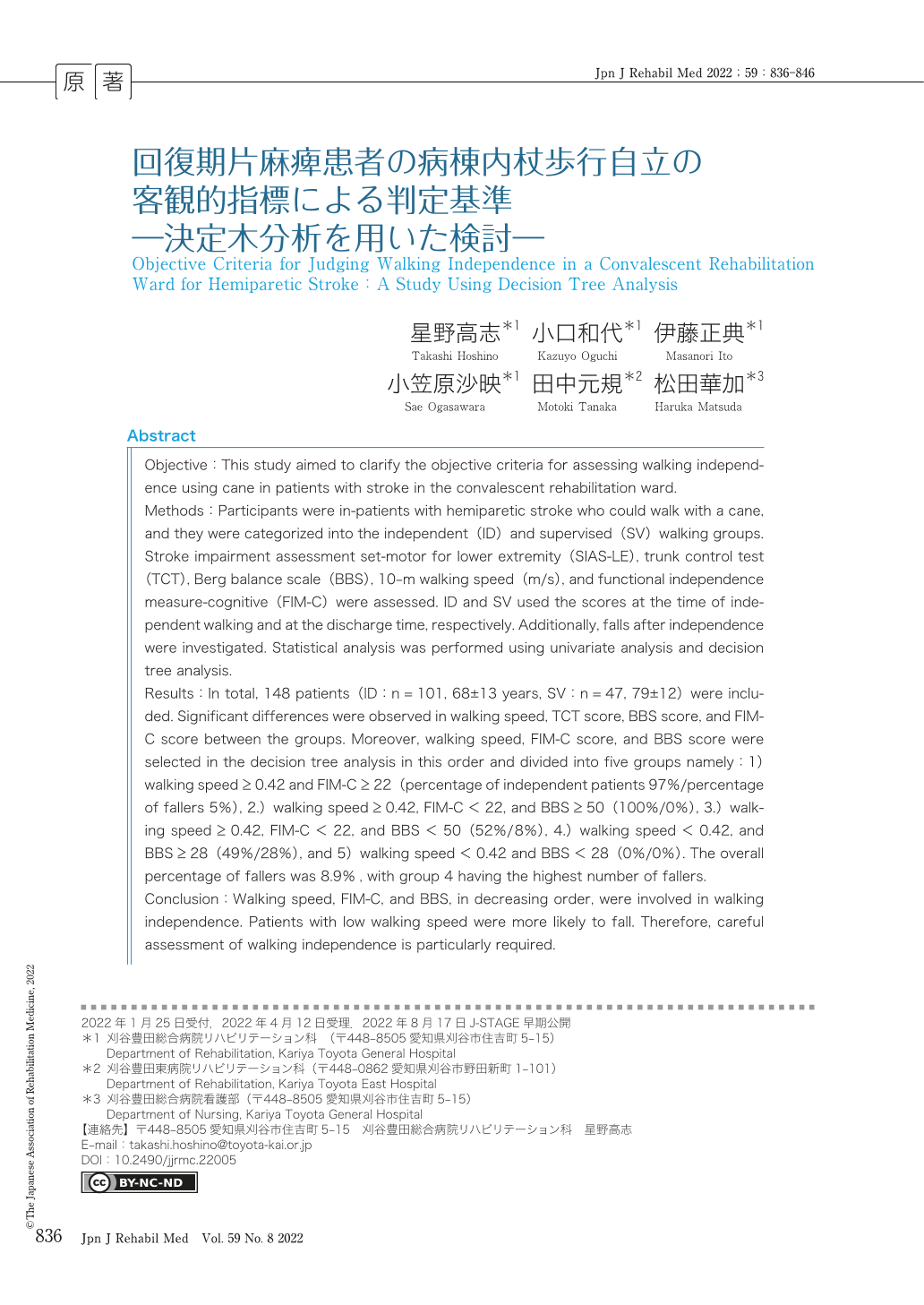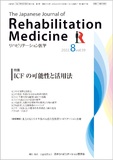Japanese
English
- 販売していません
- Abstract 文献概要
- 1ページ目 Look Inside
- 参考文献 Reference
要旨
目的:回復期リハビリテーション病棟入院中の片麻痺患者における病棟内杖歩行自立の客観的判定基準を,決定木分析を用いて明らかにする.
方法:対象は3年間の脳卒中片麻痺患者のうち,退院時の杖歩行が監視以上の者とし,病棟内杖歩行自立群と非自立群に分けた.評価項目はSIAS下肢運動合計(SIAS-LE),Trunk Control Test(TCT),Berg Balance Scale(BBS),10m歩行速度(m/s),入院時FIM認知合計(FIM-C)とし,自立群は歩行自立時,非自立群は退院時の評価を用いた.さらに歩行自立後の転倒状況も調査した.統計分析は単変量解析および決定木分析を行った.
結果:自立群101名(平均68±13歳),非自立群47名(平均79±12歳)で,歩行速度,TCT,BBS,FIM-Cに有意差を認めた.決定木分析では歩行速度,FIM-C,BBSの順に選択され,①歩行≧0.42m/s,FIM-C≧22点(自立者割合97%/転倒者割合5%),②歩行≧0.42m/s,FIM-C<22点,BBS≧50点(100%/0%),③歩行≧0.42m/s,FIM-C<22点,BBS<50点(52%/8%),④歩行<0.42m/s,BBS≧28点(49%/28%),⑤歩行<0.42m/s,BBS<28点((0%/0%)に分けられた.転倒者割合は全体で8.9%,うち④が最も高かった.
結論:歩行自立には歩行速度,FIM-C,BBSの順に関与し,各基準値が明らかになった.歩行速度の低い者は易転倒傾向であり,特に慎重な自立判断が求められる.
Abstract
Objective:This study aimed to clarify the objective criteria for assessing walking independence using cane in patients with stroke in the convalescent rehabilitation ward.
Methods:Participants were in-patients with hemiparetic stroke who could walk with a cane, and they were categorized into the independent (ID) and supervised (SV) walking groups. Stroke impairment assessment set-motor for lower extremity (SIAS-LE), trunk control test (TCT), Berg balance scale (BBS), 10-m walking speed (m/s), and functional independence measure-cognitive (FIM-C) were assessed. ID and SV used the scores at the time of independent walking and at the discharge time, respectively. Additionally, falls after independence were investigated. Statistical analysis was performed using univariate analysis and decision tree analysis.
Results:In total, 148 patients (ID:n=101, 68±13 years, SV:n=47, 79±12) were included. Significant differences were observed in walking speed, TCT score, BBS score, and FIM-C score between the groups. Moreover, walking speed, FIM-C score, and BBS score were selected in the decision tree analysis in this order and divided into five groups namely:1) walking speed ≥ 0.42 and FIM-C ≥ 22 (percentage of independent patients 97%/percentage of fallers 5%), 2.) walking speed ≥ 0.42, FIM-C < 22, and BBS ≥ 50 (100%/0%), 3.) walking speed ≥ 0.42, FIM-C < 22, and BBS < 50 (52%/8%), 4.) walking speed < 0.42, and BBS ≥ 28 (49%/28%), and 5) walking speed < 0.42 and BBS < 28 (0%/0%). The overall percentage of fallers was 8.9%, with group 4 having the highest number of fallers.
Conclusion:Walking speed, FIM-C, and BBS, in decreasing order, were involved in walking independence. Patients with low walking speed were more likely to fall. Therefore, careful assessment of walking independence is particularly required.

Copyright © 2022, The Japanese Association of Rehabilitation Medicine. All rights reserved.


